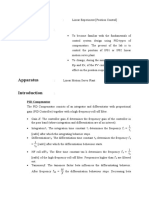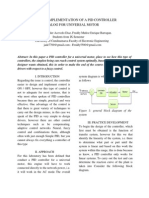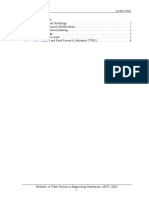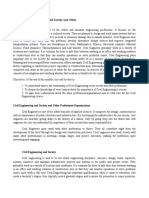Modul 3
Uploaded by
Rifki YafiModul 3
Uploaded by
Rifki YafiModul 3
Sistem Kendali Posisi
0 Tujuan
Tujuan dari percobaan ini adalah memahami konsep pengendalian posisi motor DC. Agar pemahaman dari
konsep pengendalian posisi motor bisa tercapai, maka dalam percobaan ini diharapkan mampu untuk:
a. Memahami konsep system pengendalian posisi motor DC secara umum
b. Memahami sistem pengendalian PID (khususnya proporsional-derivative) beserta karakteristiknya
dalam sistem pengendalian posisi motor DC
c. Mengimplementasikan sistem pengendalian posisi motor DC menggunakan QNET DCMCT
Note:
1. Berhati-hatilah dalam menggunakan peralatan praktikum Sistem Kendali.
2. Hapus kembali semua data yang Anda simpan di komputer selama praktikum (termasuk
unduhan modul, hasil screenshoot, dll.).
3. Silakan cari referensi tambahan untuk menjadi bahan Teori Dasar praktikum dalam penulisan
laporan
Modul Praktikum Sistem Kendali Teknik Elektro ITERA – QNET DCMCT | 1
1 Background
The control of the motor position is a natural way to introduce the benefits of derivative action. This
laboratory experiment focuses on qualitative proportional-derivative position control, and a controller
similar to Figure 1.1 will be used.
Figure 1.1: QNET DC Motor PID closed-loop block diagram
The two-degree of freedom PID transfer function inside the PID block in Figure 1.1 is
𝑢 = 𝑘 (𝑏 𝑟(𝑡) − 𝑦(𝑡) + 𝑘 𝑟(𝜏) − 𝑦(𝜏) 𝑑𝜏 + 𝑘 (𝑏 𝑟̇ (𝑡) − 𝑦̇ (𝑡)) (1.1)
where kp is the position proportional control gain, kd is the derivative control gain, ki is the integral
control gain, bsp
is the set-point weight on the reference position r(t), and bsd is the set-point weight on the velocity
reference of r(t).
The dotted box labeled Motor in Figure 1.1 is the motor model in terms of the back-emf motor constant
km , the electrical motor armature resistance Rm , and the equivalent moment of inertia of the motor
pivot Jeq . The direct disturbance applied to the inertial wheel is represented by the disturbance torque
variable Td and the simulated disturbance voltage is denoted by the variable Vsd.
1.1 PD Control Design
The behaviour of the controlling the motor position is first analyzed using a PD control. By setting ki = 0
in the PID control equation Equation 1.1 and taking its Laplace transform, the PD transfer function is
𝑢 = 𝑘 (𝑟 − 𝑦) + 𝑘 𝑠(𝑏 𝑟 − 𝑦) (1.2)
Combining the position process model
𝛩 (𝑠) 𝐾
=
𝑉 (𝑠) 𝑠(𝜏𝑠 + 1)
with the PD control Equation 1.2 gives the closed-loop transfer function of the motor position system
𝐾(𝑘 + 𝑏 𝑘 𝑠)
𝐺 , (𝑠) =
𝜏𝑠 + (1 + 𝐾𝑘 )𝑠 + 𝐾𝑘
Modul Praktikum Sistem Kendali Teknik Elektro ITERA – QNET DCMCT | 2
Similarly to the speed control laboratory, the standard characterictic function shown in Equation 1.3 can
be achieved by seetting the proportional gain to
𝜔 𝜏 (1.3)
𝑘 =
𝐾
and the derivative gain to
−1 + 2𝜁𝜔 𝜏 (1.4)
𝑘 =
𝐾
1.2 Response to Load Disturbances
Next, the behaviour of the PID closed-loop system when it is subjected to a disturbance is examined. The
block diagram shown in Figure 1.2 represents the load disturbance to position response when bsp and bsd
in the PID in Equation 1.1 are both set to 1.
Figure 1.2: PID closed-loop block diagram to a load disturbance input
The closed-loop disturbance to position transfer function is
𝜏𝑠
𝐺 , (𝑠) = (1.5)
𝐽 (𝜏𝑠 + (1 + 𝐾𝑘 )𝑠 + 𝐾𝑘 𝑠 + 𝐾𝑘
Given a step disturbance with an amplitude of Td0
𝑇
𝑇 (𝑠) =
𝑠
The steady-state angle of the closed-loop system is
𝜃 = 𝑇 lim 𝐺 , (𝑠)
→
The steady-state angle of the PD control, that is when k i = 0 in 1.5 is
𝜏𝑇
𝜃 _ =
𝐽 𝐾𝑘
The steady state-angle with integral action is
𝜃 _ =0
Thus when the system is subected to a disturbance, a constant steady-state error is observed when using the
PD control system. However, the disturbance is rejected when the integral control is used and the steady-
state angle eventually goes to zero.
Modul Praktikum Sistem Kendali Teknik Elektro ITERA – QNET DCMCT | 3
PID control design involves using the standard characteristic equation for a third-order system
(𝑠 + 2𝜁𝜔 + 𝜔 )(𝑠 + 𝑝 ) = 𝑠 + (2𝜁𝜔 + 𝑝 )𝑠 + (𝜔 + 2𝜁𝜔 𝑝 )𝑠 + 𝜔 𝑝 (1.6)
where the 𝜔 is the natural frequency, 𝜁 is the damping ratio, dan 𝑝 is a zero. The characteristic equation
of the closed-loop PID transfer function, i.e. the denominator of the transfer function 1.5 is
𝐾𝑘 + 1 𝐾𝑘 𝐾𝑘 (1.7)
𝑠 + 𝑠 + 𝑠+
𝜏 𝜏 𝜏
The PID characteristic equation 1.7 matches 1.6 using the proportional gain
𝜔 𝜏(𝜔 + 2𝜁𝑝 )
𝑘 =
𝐾
The derivative gain
−1 + 2𝜁𝜔 𝜏 + 𝑝 𝜏
𝑘 =
𝐾
And the integral gain
𝜔 𝑝 𝜏
𝑘 =
𝐾
By varying the zero location, 𝑝 , the time required by the closed-loop response to recover from a disturbance
is changed.
Modul Praktikum Sistem Kendali Teknik Elektro ITERA – QNET DCMCT | 4
2 In-Lab Exercise
2.1 Qualitative PD Control
1. Ensure the QNET_DCMCT_Position_Control.vi is open. Make sure the correct Device is chosen.
2. Run the VI. The DC motor should begin rotating and the scopes should look similar to Figure 1.4.
3. In the Signal Generator section set:
• Amplitude = 2.00 rad
• Frequency = 0.40 Hz
• Offset = 0.00 rad
4. In the Control Parameters section set:
• kp = 2.00 V/rad
• ki = 0.00 V/rad
• kd = 0.00 Vs/rad
5. Change the proportional gain, kp, by steps of 0.25 V/rad. Try the following gains: kp = 0.5, 1, 2, and
4 V/rad.
6. Examine the behavior of the measured position (red line) with respect to the reference position (blue
line) in the Position (rad) scope. Explain what is happening.
7. Describe the steady-state error to a step input.
8. Increment the derivative gain, kd by steps of 0.01 Vs/rad
9. Look at the changes in the measured position with respect to the desired position. Explain what is
happening..
10. Stop the VI by clicking on the Stop button.
2.2 PD Control According to Specifications
1. Calculate the expected peak time tp and percent overshoot PO given the following Speed Lab Design
(SLD) spesifications:
• ζ = 0.60,
• ω0 = 25.0 rad/s.
• p0 = 0.0
Optional: You can also design a VI that simulates the QNET DC Motor first-order model with a PI
control and have it calculate the peak time and overshoot.
2. Calculate the proportional and derivativee control gains kp and kd , according to the model
parameters that found in Modul 1 and the SLD spesifications.
3. Ensure the QNET_DCMCT_Position_Control.vi is open. Make sure the correct Device is chosen.
4. Run the VI. The DC motor should begin spinning and the scopes should look similar to Figure 1.3.
5. In Signal Generator set:
Modul Praktikum Sistem Kendali Teknik Elektro ITERA – QNET DCMCT | 5
Amplitude = 2.00 rad
Frequency = 0.40 Hz
Offset = 0.00
6. In the Control Parameters section, enter the PD control gains found in Step 2
7. Capture the position response found in the Position (rad) scope and control signal used in the Voltage
(V) scope
8. Measure the peak time and percentage overshoot of the measured SLD response. Are the
specifications satisfied?
9. What effect does increasing the specification ζ have on the measured speed response? How about
on the control gains? Use the damping ratio equation given in the Peak Time and Overshoot section
of the Background for more help if needed.
10. What effect does increasing the specification w0 have on the measured speed response and the
generated control gains? Use the natural frequency equation found in the Peak Time and Overshoot
section of the Background for more help if needed.
11. Stop the VI by clicking on the Stop button.
Description Symbol Value Unit
Model gain used K rad/s
Model time constant used τ s
Proportional gain kp V/(rad/s)
Derivative gain kd V/rad
Calculated peak time tp s
Calculated percent overshoot PO %
Measured peak time tp s
Measured percent overshoot PO %
2.3 Response to Load Disturbance
1. In the Response to Load Disturbance section, the load disturbance to motor position closed-loop PID
block diagram is found. Consider the same regulation system, r = 0 , when bsp = 1 and bsd = 1 and
show the block diagram representing the simulated disturbance to motor position closed-loop
interaction (in this case Td = 0)
2. Find the closed-loop PID transfer function describing the position of the motor with respect to the
simulated disturbance voltage: G0,Vsd(s) = Θ(s)/Vsd(s)
3. Find the steady-state motor angle due to a simulated disturbance step of V sd = Vsd0/s
4. A step of Vsd = Vsd0/s with Vsd0 = 3 is added to the motor voltage to simulate a disturbance torque.
Evaluate the steady-state angle of the motor when a PD controller is used with the gains kp = 2 V/rad
and kd = 0.02 V.s/rad. Then, calculate the steady-state angle when using a PID controller with the
gains kp = 2 V/rad, kd = 0.02 V.s/rad, and ki = 1 V/rads
5. Ensure the QNET_DCMCT_Position_Control.vi is open. Make sure the correct Device is chosen.
6. Run the VI. The DC motor should begin rotating.
7. In the Signal Generator section set:
Modul Praktikum Sistem Kendali Teknik Elektro ITERA – QNET DCMCT | 6
Amplitude = 0.00 rad
Frequency = 0.40 Hz
Offset = 0.00 rad
8. In the Control Parameters section set:
kp = 2.0 V/rad
ki = 0.0 V/rad.s
kd = 0.02 V.s/rad
9. Apply the disturbance by clicking on the Disturbance toogle switch situated below the Signal
Generator.
10. Examine the effect of the disturbance on the measured position. Attach a response of the motor
position when the disturbance is applied, record the obtained steady-state angle, and compare it to the
value estimated in Step 3.
11. Turn OFF the Disturbance switch
12. In the Control Parameters section set:
kp = 2.0 V/rad
ki = 2.0 V/rad.s
kd = 0.02 V.s/rad
13. Apply the disturbance by clicking on the Disturbance toogle switch situated below the Signal
Generator.
14. Examine the effect of the disturbance on the measured position. Attach a response of the motor
position when the disturbance is applied, record the obtained steady-state angle, and compare it to the
value estimated in Step 3.
15. Stop the VI by clicking on the Stop button.
Description Symbol Value Unit
Calculated PD steady-state error 𝜃 _ rad
Calculated PID steady-state error 𝜃 _ rad
Measured PD steady-state error 𝜃 _ rad
Measured PID steady-state error 𝜃 _ rad
Modul Praktikum Sistem Kendali Teknik Elektro ITERA – QNET DCMCT | 7
You might also like
- Speed Control of DC Motor Using Pid ControllerNo ratings yetSpeed Control of DC Motor Using Pid Controller20 pages
- Proportional and Derivative Control DesignNo ratings yetProportional and Derivative Control Design5 pages
- Position Control System: Transducer Amplifier Motor & Gearing Output Shaft Error + InputNo ratings yetPosition Control System: Transducer Amplifier Motor & Gearing Output Shaft Error + Input6 pages
- To Observe The Effect of Controller On DC Motor To Control Its Speed and PositionNo ratings yetTo Observe The Effect of Controller On DC Motor To Control Its Speed and Position9 pages
- Lab 09 Speed Control of QNET DC Motor Using PI ControlNo ratings yetLab 09 Speed Control of QNET DC Motor Using PI Control4 pages
- Motor Control System Development Using Microcontroller Based On Pid ControllerNo ratings yetMotor Control System Development Using Microcontroller Based On Pid Controller39 pages
- Modeling of Open Loop System and Study of Their Open Loop Response50% (2)Modeling of Open Loop System and Study of Their Open Loop Response13 pages
- MECH 450 Lab Assignment 4 - Controlling DC Motor PositionNo ratings yetMECH 450 Lab Assignment 4 - Controlling DC Motor Position3 pages
- SKEE 3732 Basic Control Laboratory Angular Position Control: Experiment 2No ratings yetSKEE 3732 Basic Control Laboratory Angular Position Control: Experiment 28 pages
- Lab 13 - Implementation of DC Motor Position ControlNo ratings yetLab 13 - Implementation of DC Motor Position Control3 pages
- Lab 2 - Analyze The Performance of Control SystemNo ratings yetLab 2 - Analyze The Performance of Control System11 pages
- Introduction To Simulink (Implementing PD Controller) : Control LaboratoryNo ratings yetIntroduction To Simulink (Implementing PD Controller) : Control Laboratory6 pages
- (P1) Modul DC Motor Speed Control SystemNo ratings yet(P1) Modul DC Motor Speed Control System13 pages
- Closedloop PID Control of Universal MotorNo ratings yetClosedloop PID Control of Universal Motor9 pages
- Position Control of A DC Servo Using A PID PDF0% (1)Position Control of A DC Servo Using A PID PDF28 pages
- DC Motor Speed Control PID Implementation Simulink PDFNo ratings yetDC Motor Speed Control PID Implementation Simulink PDF12 pages
- Digital PID Control System For DC Servo Motor Using VHDL CodeNo ratings yetDigital PID Control System For DC Servo Motor Using VHDL Code4 pages
- Time Response of A Second-Order DC Motor Unit Feedback SystemNo ratings yetTime Response of A Second-Order DC Motor Unit Feedback System6 pages
- Drive Unit 4 Closed Loop Control of DC DriveNo ratings yetDrive Unit 4 Closed Loop Control of DC Drive22 pages
- Control of DC Motor Using Different Control StrategiesFrom EverandControl of DC Motor Using Different Control StrategiesNo ratings yet
- Student Solutions Manual to Accompany Economic Dynamics in Discrete Time, secondeditionFrom EverandStudent Solutions Manual to Accompany Economic Dynamics in Discrete Time, secondedition4.5/5 (2)
- Chapter 11 Introduction To Urban HydrologyNo ratings yetChapter 11 Introduction To Urban Hydrology7 pages
- RMO Exercises Topic 1: Sophisticated AdjectivesNo ratings yetRMO Exercises Topic 1: Sophisticated Adjectives6 pages
- Applications of Statistics in Daily LifeNo ratings yetApplications of Statistics in Daily Life11 pages
- Prof 1, Sem 1 L 45 - CLASSIFICATION OF AKHLAT (HUMOURS100% (1)Prof 1, Sem 1 L 45 - CLASSIFICATION OF AKHLAT (HUMOURS14 pages
- Strategic Human Resource Management: Mba Iv SemNo ratings yetStrategic Human Resource Management: Mba Iv Sem6 pages
- Download ebooks file Data Management at Scale, Second Edition Piethein Strengholt all chapters100% (1)Download ebooks file Data Management at Scale, Second Edition Piethein Strengholt all chapters37 pages
- Towards Italian Opera Houses: A Review of Acoustic Design in Pre-Sabine ScholarsNo ratings yetTowards Italian Opera Houses: A Review of Acoustic Design in Pre-Sabine Scholars29 pages
- List of Selected Candidates Department of Biological SciencesNo ratings yetList of Selected Candidates Department of Biological Sciences14 pages
- Civil Engineering and Society and Other Engineering Professions - 1No ratings yetCivil Engineering and Society and Other Engineering Professions - 16 pages
- Kuliah 6 Prosedur Terjemahan Newmark AAWNo ratings yetKuliah 6 Prosedur Terjemahan Newmark AAW24 pages
- Measurements of Length, Mass, Density, and TimeNo ratings yetMeasurements of Length, Mass, Density, and Time5 pages
- BARANGAY HIZON FISH SANCTUARY Revised Management Plan (Draft) 2016-2021No ratings yetBARANGAY HIZON FISH SANCTUARY Revised Management Plan (Draft) 2016-202125 pages
- Position Control System: Transducer Amplifier Motor & Gearing Output Shaft Error + InputPosition Control System: Transducer Amplifier Motor & Gearing Output Shaft Error + Input
- To Observe The Effect of Controller On DC Motor To Control Its Speed and PositionTo Observe The Effect of Controller On DC Motor To Control Its Speed and Position
- Lab 09 Speed Control of QNET DC Motor Using PI ControlLab 09 Speed Control of QNET DC Motor Using PI Control
- Motor Control System Development Using Microcontroller Based On Pid ControllerMotor Control System Development Using Microcontroller Based On Pid Controller
- Modeling of Open Loop System and Study of Their Open Loop ResponseModeling of Open Loop System and Study of Their Open Loop Response
- MECH 450 Lab Assignment 4 - Controlling DC Motor PositionMECH 450 Lab Assignment 4 - Controlling DC Motor Position
- SKEE 3732 Basic Control Laboratory Angular Position Control: Experiment 2SKEE 3732 Basic Control Laboratory Angular Position Control: Experiment 2
- Lab 13 - Implementation of DC Motor Position ControlLab 13 - Implementation of DC Motor Position Control
- Introduction To Simulink (Implementing PD Controller) : Control LaboratoryIntroduction To Simulink (Implementing PD Controller) : Control Laboratory
- DC Motor Speed Control PID Implementation Simulink PDFDC Motor Speed Control PID Implementation Simulink PDF
- Digital PID Control System For DC Servo Motor Using VHDL CodeDigital PID Control System For DC Servo Motor Using VHDL Code
- Time Response of A Second-Order DC Motor Unit Feedback SystemTime Response of A Second-Order DC Motor Unit Feedback System
- Control of DC Motor Using Different Control StrategiesFrom EverandControl of DC Motor Using Different Control Strategies
- Student Solutions Manual to Accompany Economic Dynamics in Discrete Time, secondeditionFrom EverandStudent Solutions Manual to Accompany Economic Dynamics in Discrete Time, secondedition
- Prof 1, Sem 1 L 45 - CLASSIFICATION OF AKHLAT (HUMOURSProf 1, Sem 1 L 45 - CLASSIFICATION OF AKHLAT (HUMOURS
- Download ebooks file Data Management at Scale, Second Edition Piethein Strengholt all chaptersDownload ebooks file Data Management at Scale, Second Edition Piethein Strengholt all chapters
- Towards Italian Opera Houses: A Review of Acoustic Design in Pre-Sabine ScholarsTowards Italian Opera Houses: A Review of Acoustic Design in Pre-Sabine Scholars
- List of Selected Candidates Department of Biological SciencesList of Selected Candidates Department of Biological Sciences
- Civil Engineering and Society and Other Engineering Professions - 1Civil Engineering and Society and Other Engineering Professions - 1
- BARANGAY HIZON FISH SANCTUARY Revised Management Plan (Draft) 2016-2021BARANGAY HIZON FISH SANCTUARY Revised Management Plan (Draft) 2016-2021

























































































